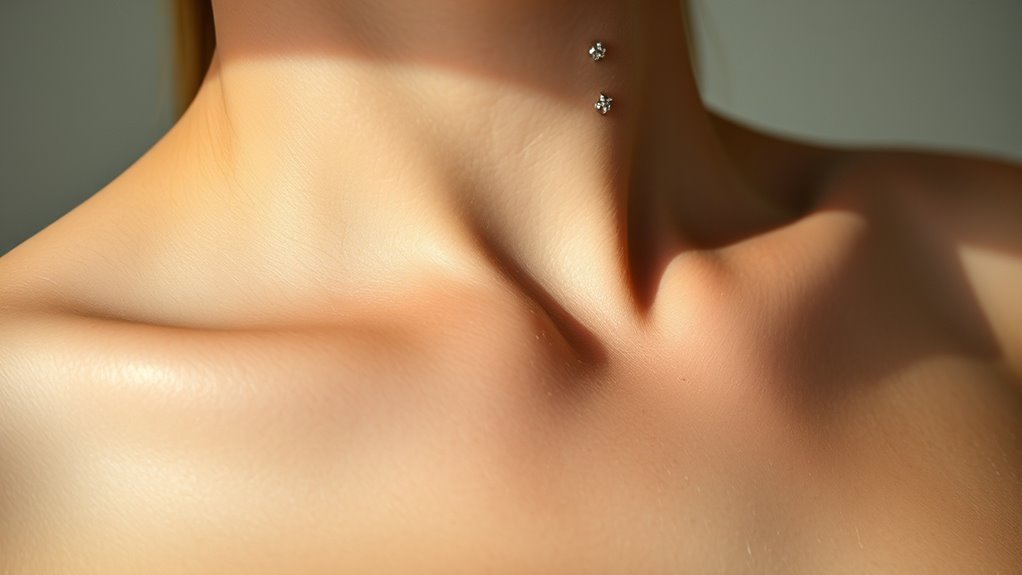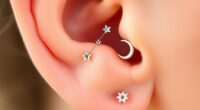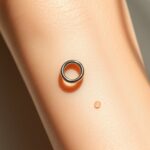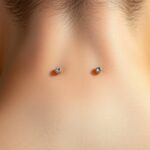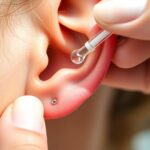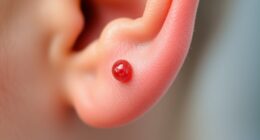Surface anchor piercings on the nape, collarbone, and hips involve a healing process that can take several months, so patience and proper aftercare are vital. You should clean them gently twice daily, wear loose clothing, and avoid irritants or trauma. Watch for signs of infection like redness or pus, and seek help if needed. With careful care, you can enjoy your piercing longer—discover more tips to guarantee your healing goes smoothly.
Key Takeaways
- Proper aftercare, including gentle cleaning twice daily, promotes healing of surface anchor piercings at the nape, collarbone, and hips.
- Healing duration varies; patience and avoiding trauma are essential for successful recovery in these areas.
- Wear loose, breathable clothing to reduce irritation and minimize disruption during healing.
- Watch for signs of infection like swelling, redness, or pus; seek prompt medical advice if necessary.
- Avoid swimming and harsh chemicals during healing to prevent infection and promote optimal healing conditions.

Have you ever wondered how surface anchor piercings stay securely in place on the skin’s surface? These piercings are designed with tiny anchors beneath the skin that hold the jewelry in position, but their success depends heavily on proper piercing healing and diligent aftercare tips. When you get a surface anchor piercing on areas like the nape, collarbone, or hips, you’re tapping into a delicate process. The skin in these regions is thin and constantly exposed to movement and friction, which can challenge the stability of the jewelry if you don’t follow the right aftercare routine.
Piercing healing for surface anchors typically takes several months, sometimes longer, depending on your body’s response. During this period, it’s vital to keep the area clean and avoid unnecessary movement or pressure that could dislodge the anchor. You should start by gently cleaning around the piercing twice a day with saline solution or a piercing aftercare spray recommended by your piercer. Avoid harsh chemicals or alcohol, as they can irritate the skin and slow down healing. When cleaning, use a soft cloth or sterile gauze to pat the area dry—never rub.
Healing takes months; keep the area clean, avoid pressure, and use gentle saline cleaning to ensure proper recovery.
Proper aftercare tips also involve being cautious with clothing and accessories. Tight straps or rough fabrics can rub against the piercing, causing irritation or even pulling out the jewelry. Try to wear loose, breathable clothing until the piercing is fully healed. If you notice any signs of infection—such as excessive swelling, redness, pain, or pus—consult your piercer or healthcare provider promptly. Ignoring these symptoms can lead to complications and prolong the healing process.
Another important aspect of piercing healing involves avoiding unnecessary trauma to the area. Be mindful when reaching for items or sleeping, as accidental bumps can shift or damage the anchor. Refraining from swimming in pools, hot tubs, or lakes during the healing phase is also recommended, since bacteria in untreated water can cause infections. Additionally, understanding how essential oils can impact healing is useful—certain oils, if used improperly, may irritate the skin or interfere with recovery.
Consistent aftercare tips and patience are your best tools for successful piercing healing. Remember, surface anchor piercings are more prone to rejection or migration because of their placement, so it’s essential to follow your piercer’s instructions diligently. Keep the area clean, avoid irritants, and don’t rush the healing process. With proper care, your surface anchor piercing will stabilize and look stunning in due time.
Frequently Asked Questions
How Long Do Surface Anchor Piercings Typically Last?
Surface anchor piercings typically last between 1 to 3 years, but this depends on your healing time and jewelry care. If you follow proper aftercare, your jewelry can stay in good condition longer. Keep in mind that the longevity varies based on your body’s response and how well you maintain the piercings. Regular check-ins with your piercer can help guarantee your surface anchors remain secure and healthy.
What Are the Best Aftercare Practices for These Piercings?
Think of your piercing as a delicate garden that needs daily care. To avoid skin irritation, clean the jewelry with saline solution twice daily, gently removing dirt and oils. Keep the area dry and avoid touching it unnecessarily. Proper jewelry hygiene is key—inspect for signs of infection and avoid harsh chemicals. By staying vigilant and gentle, you’ll help your surface anchor piercings heal beautifully and stay comfortable.
Are Surface Anchor Piercings Painful During Healing?
During the healing process, you might experience some pain, but it generally varies with each person. The pain level is usually mild to moderate and tends to decrease over time. You may feel soreness, tenderness, or discomfort initially, but these symptoms should lessen as your body heals. Keep in mind that proper aftercare helps manage pain and supports a smoother healing process, making your experience more comfortable.
Can Surface Anchor Piercings Be Removed Easily?
Yes, surface anchor piercings can be removed relatively easily. The removal procedures are straightforward and usually involve carefully extracting the anchors. Healing timelines vary, but expect a few weeks for the skin to fully recover after removal. Keep in mind that, depending on how long you’ve had the piercing and your skin’s healing response, some residual scarring may occur. Always consult your piercer for proper removal guidance.
What Are the Risks of Scarring With Surface Anchor Piercings?
About 60% of surface anchor piercings can develop noticeable scarring. You should know that scar tissue formation is a common risk, especially if you don’t follow proper aftercare. Infection risks also increase if the piercing isn’t kept clean, which can worsen scarring. To minimize these risks, verify you follow your piercer’s instructions and avoid irritating the area, helping you keep scarring minimal and healthy healing possible.
Conclusion
Surface anchor piercings offer striking beauty and unique expression, but they come with risks and care requirements. While they can elevate your style and showcase your individuality, they also demand patience and responsibility. Embrace the contrast—boldness paired with caution, art with upkeep. Ultimately, whether you choose a nape, collarbone, or hip piercing, it’s your personal statement. Just remember, beauty is a balance between daring looks and mindful maintenance.

